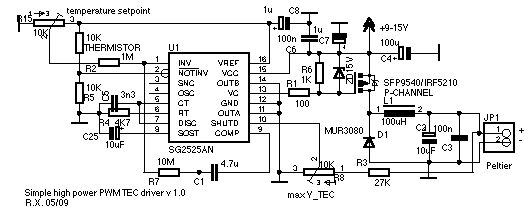
Return to home page
A good source for links for TEC controllers is this thread of photonlexicon.com.
For two reasons I needed to devolop a high power TEC controller: first, to create a temperature controlled hot/cold plate for measuring the temperature stability of various lasers and circuits, and second, I need a powerful TEC controller for cooling 40W and 60W 808nm laser diodes for my DPSS project. With high power I mean the order of 100W, or roughly 12V 9A or so, referring to the 12709 type of peltiers that are currently cheap on ebay.
Clearly a linear regulated supply is out of the question for this power, while a pulse-width-modulated controller is relatively easy to build. Certainly there are fully integrated controllers of lower power available (eg., based on MAX1968 and LTC1923 as used in my Coherent Compass 315M driver), but these very tiny SSOP SMD devices are a pain to handle and are also "too good" for this crude application. For the present purposes, small size and extreme stability is not important, and keeping the temperature constant to 0.1 degrees, say, is more than enough. So why not throw together a simple and cheap circuit based on standard components, in particular the familiar SG2525/3525, which has served very well so far in my multi-KW ion laser SMPS.
Simplest and sufficient for my purposes is a circuit that cools (or heats) only. Most ingredients for a buck converter incl. comparator opamp are already contained in the IC, and one needs to add only one mosfet, diode, inductor and a few caps and resistors:

The circuit is straightforward but requires careful layout when higher powers are involved (to prevent instabilities), inparticular a good ground plane is important. It runs at approx 100khz. The feedback loop is a simple integrator, and R7 and C1 may need to be adjusted in order to match the thermal properties of the load. Temperature is set by R15 while maximal voltage over the Peltier element is set by R8. Almost any P-channel mosfet with the appropriate current rating should do; similar applies to the diode D1. The voltage rating of both should be at least three times the supply voltage, and the current rating two times of the desired output. The inductor must be chosen properly, ie, must handle the power without saturation. The inductivity should be as high as possible, say 100uH, in order that the controller does not run in discontinous mode at low currents. For 100W or so output, the toroidal core of the main inductor of a standard computer power supply probably does just fine (with 10 turns, say). For further remarks, see my the notes on my ion laser SMPS.
For low power applications with max current in the order of 1A (like for cooling DVD diode lasers), all components can be small SMD devices, as the power dissipation is minimal.
Notes added:

Return to home page
Vers. 0.9 -05/09